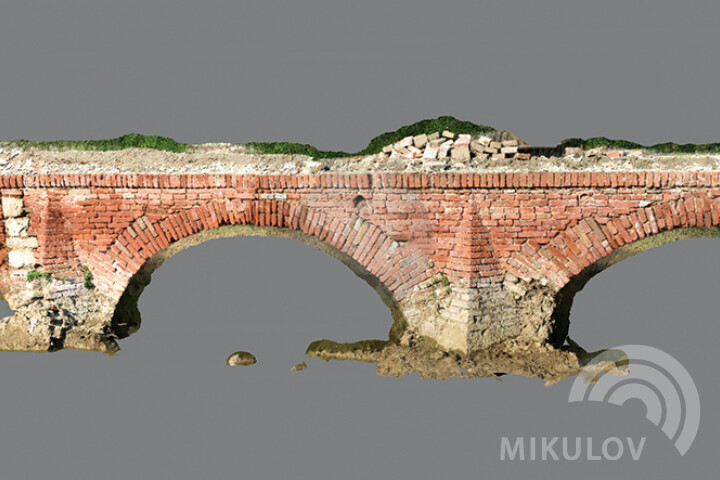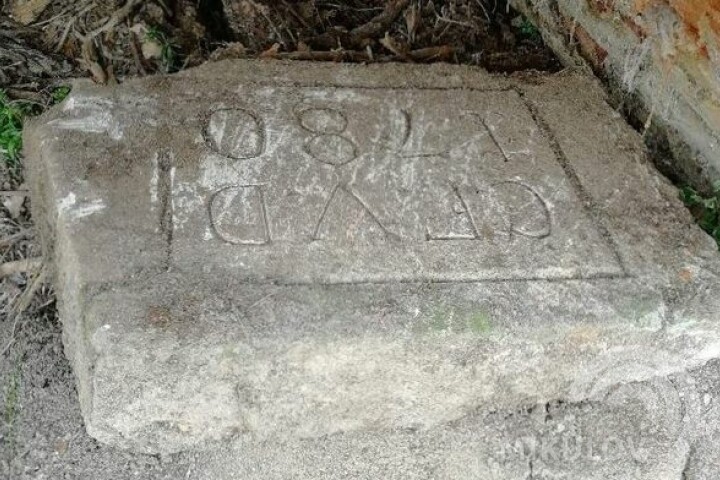The historical brick bridge is in all respects a unique structure not only in this country, but also on a broader European scale.
It fascinates by its age, and it is unparalleled as to the selection of the used material and building design. It differs from the common pond and river bridges through its construction form and also its function. It was built as part of a well-considered architectural plan including the other buildings on the island and landscaping and by its form it elevated the esthetic effect of the prestigious complex.
Origin and construction of the bridge
The situation of a hunting lodge on the limestone monadrock raised above water in the middle of Portz pond (also known as Nový), built in the late Middle Ages, also raised a question of accessibility of the site across the broad expanse of water. It is hard to imagine the delivery of building materials for the construction could only be secured by boat. This may prompt a consideration that already during the summer house construction, perhaps some time during the 1620s, there existed access to the island by land, i.e. via a bridge. Historical sources do not specify the construction of a brick bridge on Portz Insel, so we may only wonder whether it was already in place during the summer residence construction, or it was preceded by some temporary wooden structure.
The bridge located at the narrowest point of the pond still reached a respectable length of 95 m, its width being 3.70 m. It consists of fifteen semicircular vaulted arches, divided by pilasters with double-sided pyramidal edges. The bridge deck was lined with a solid, approx. 75 cm high parapet wall. The outer fully bricked sections were ended with short open wings with decoratively shaped fenders at the ends. The tenth section of the bridge from the south had originally been a wooden lifting deck; it was still documented on the maps from as late as the 1830s, but shortly afterwards it was removed and the empty section was bricked up in a similar manner as the other parts of the bridge. After being vaulted, the part of the deck in the originally unfilled segment was also paved with limestone cubes. During the present restoration, accompanied by archeological survey, it was found that the stone pavement had an approx. 5–10 cm thick layer of fine limestone gravel on it. The engineering design of the bridge was very well thought out. The part of the columns below and slightly above the water surface was made of large blocks of hewed stone, the remainder was built of brick. The bridge arches themselves widen at two points towards the base and the bricks on the front face are hewed in the shape of a decorative arch keystone. Also the pyramidal shape of the edges was obtained through final hewing the brick masonry to shape. Uniquely preserved is the drainage solution for the bridge deck, using drainage openings lined with curved roof tiles, known as tegulas.

The picture shows a cutout of the overall 3D model of the bridge created by laser scanning within an archeological survey in 2019. The purpose of the scanning was to identify the scope of the preserved original elements of the bridge. A later alteration is visible on the first arch from the left, where the extended vault replaced the old wooden drawbridge. Source: Ing. Miloš Tejkal
Interesting facts about the bridge construction
For the sake of comparison: the bridges across the river Dyje on this estate and the neighbouring Liechtenstein land alike used to be wooden as late as the 19th century – only exceptionally from combined materials, such as the late Baroque bridge in Bulhary. The builder had not only in mind the visual impact of the bridge on the visitor, but also, through incorporating the section with the lifting deck as an element of defensive architecture, he sought to create an impression of a fortress-like character of the place, which corresponded, too, with the terraced walls around the summer residence. It is a consummate engineering work which leaves us with the question about who was its originator - perhaps one of the northern Italian fortress master builders, who at that time worked for influential, politically active aristocrats in Bohemia and Moravia.
The Mikulov estate had a sufficient use of quarries supplying stone for constructional elements of the bridge as well as its pavement and penning of the deck. The 17th century land registers record 13 of them. They were situated in various localities of the estate, with limestone predominantly being quarried around Mikulov and the Portz Island. Bricks, too, were of local origin, as shown by their marking with the letter N (Nicolsburg). In the first half of the 17th century there was only one brickworks in Mikulov, however with its three kilns surprisingly large for its time. Given the same technology used, it was also possible to burn lime at the brickworks, used in turn to make mortar for the bridge construction. In the mid-17th century, perhaps owing to the consequences of the Thirty Years’ War, only two brick kilns were left in operation: one for 24 000 and the other for 19 000 bricks per one kiln-firing. Other brickyards were in the nearby villages within the estate, such as Dolní Věstonice, Sedlec u Mikulova, Bulhary and Pavlov.
Repair of the Bridge
Thanks to the inimitable quality of the bricks made by Mikulov’s skilful brickmakers of the 17th century, the construction has been preserved to this day. As the whole area had been tightly enclosed over the period of 40 years under the totalitarian regime, the bridge was in a state of disrepair when the restoration carried out from 2019 to 2020 saved it for the future.
The whole reconstruction was rather demanding. When the work began, the bridge was for the most part covered in earth and almost completely overgrown by greenery. The first thing to do was to uncover the bridge. This involved removing of earth around the bridge, cutting of wind-dispersed trees and shrubs and clearing of deposits from the carriageway of the bridge. Only then the actual extent of damage of the bridge could be established.
When the work began, the bridge was for the most part covered in earth and almost completely overgrown by greenery. The first thing to do was to uncover the bridge. This involved removing of earth around the bridge, cutting of wind-dispersed trees and shrubs and clearing of deposits from the carriageway of the bridge. Only then the actual extent of damage of the bridge could be established. The process of repairing of the bridge can be divided into two parts. One focuses on the repair of the existing lower part below the bridge ledge and the other on replacement of its missing brick railing. Within the reconstruction of the lower part of the bridge we endeavoured to use the greatest possible amount of the original bricks that had been found during extraction of the earth around the bridge. The bricks were made in the first half of the 17th century and are very good quality. Most of them are marked with the letter N (for Nikolsburg). The missing brick railing of the bridge was then built of the bricks originating from the mid-19th century. The brick railing was built up to its original height and it was extended by a simple forged section to reach the height of 110 cm. The steel railing of a simple design manifests its contemporary character, so it is obvious also to a lay visitor that the railing is not part of the original bridge. This solution complies with the present legal requirements for safe operation of the construction as well as those of the conservationists.
The whole reconstruction was a demanding project. There were a lot of surprises in store for us during the works. For example, after clearing the bridge deck of the layer of earth, in some places of up to half a metre thick, the original limestone cubes from the time of the bridge construction (the 1st half of the 17th century) were found. The paving was repaired and for the sake of its protection is now hidden underneath a threshing floor. There were many cracks detected in the arches and bottom sections of the bridge, which had to be structurally secured. Also the stone columns of the bridge had been rather extensively damaged and the missing stones had to be newly hewed and added where needed.
The project aim was also to make the bridge accessible. In the past, the bridge was connected to a road network which, however, fell into disrepair after the Second World War. The roads have been resurfaced within the project and now lead as far as the village of Drasenhofen. We have also developed an educational trail in the area for visitors to get their bearings and learn some interesting facts about the site. The trail includes 7 stops (6 infopanels and 1 resting point).
After the completion of excavations and earth removing around the bridge, the groundwater started rising during the construction works. By the end of the winter break, the levels of Rybniční brook and the stretch of water around the bridge became equal. Therefore it was necessary to alter the part of the project which tackled the return of the stream to its bed from its temporary diversion. Finally, it is planned for a small lake to be created around the repaired bridge, so it could again be reflected on the water surface.
The intention of the project was not only to repair the bridge, but also to make it accessible. In the past, the bridge was connected to the road network, which, however, completely disappeared after World War II, so the bridge was completely inaccessible. As part of the Portz Insel project, these roads were therefore re-established. These now lead to Drasenhofen, Austria. As part of the project, an educational trail was also built for easier orientation of visitors in this locality.

A stone slab found during the repair of the bridge under the additionally walled arch of the bridge over a canceled wooden drop field. The year 1780 is supplemented by the letters C.F.V.D., which means Carl Fürst von Dietrichstein. They are thus the initials of the then reigning Prince Charles Maximilian of Dietrichstein (1702 - 1784).
Before the commencement of works there was an examination with a metal detector undertaken by the Archeo Moravia association. Among other items there were 3 coins found - two pieces of 2 Heller from the era of Austria-Hungary (1894 and 1911), and one fragment, apparently damaged by a through-shot, probably a 10-heller from the CSSR (1953-1976). Further a group of bullet casings from different periods was uncovered, most of them from the period of World War II. Several horseshoes were found in the metal waste. The character of the finds testifies to the modern-day treatment of the surface layer of the bridge.































































